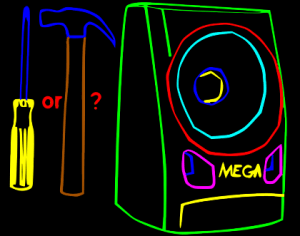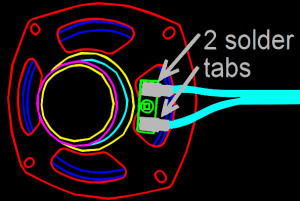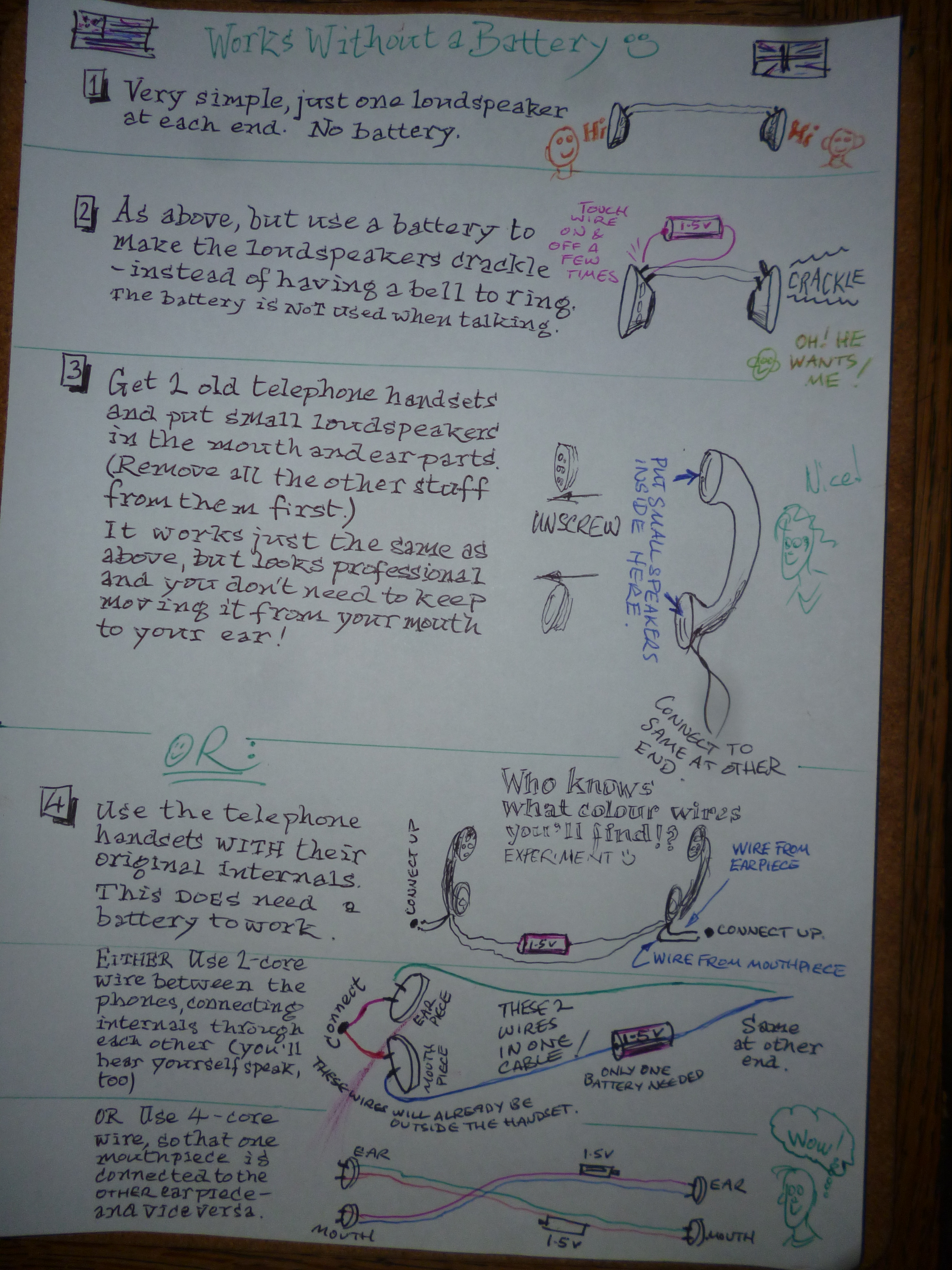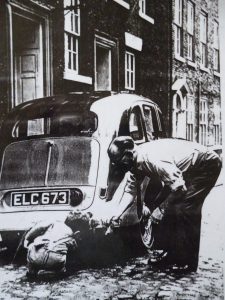Easy as a tin can phone, and it goes around corners.
Project Index

Note: This is not about the device known to most people as a speaker phone. Rather, this speaker-phone is a phone or inter-com made from old speakers.
Introduction
Alas, boom boxes (do you remember those?) and other stereo audio systems don't last forever. When they are thrown out, the speakers that came with them usually meet the same fate. It doesn't take much effort to turn those speakers into a two-way phone that kids can use safely, and kids can participate in the making. It even generates its own bit of electricity, with each speaker also acting as a microphone. So you don't need batteries. Ultimately it provides a great tool for understanding the interaction between sound and electricity.
Make a Speaker Phone
The extent of this project is two speakers with doubled wire connecting them. That's all! Although I advise how you can extract the speakers from their boxes and several options for connecting the wires, don't lose track of the simplicity of it.Although I advise how you can extract the speakers from their boxes and several options for connecting the wires, don't lose track of the simplicity of it.
What You Need
- Two speakers
All but the most extremely cheap sound systems have at least two speakers because stereo sounds much better than mono. Step 1 has some pointers for removing the speakers. If there are several sized speakers in a box, you want the big one, the "woofer." - Lamp cord or other wire
Lamp cord is the kind of wire used for most lights. It has two conductors with no ground wire. It might seem like overkill to use such stout wire for the extremely tiny bits or electrical current the speakers will generate. Indeed, you can substitute just about any wire you have around, even much thinner wire. I like lamp cord, however, because it is available in any hardware store or building center, fairly cheap and very strong. Finally, the ample thickness of the copper in lamp cord will conduct the electrical pulses with hardly any "line loss" if you are going really long distances. Old extension cords that you wouldn't trust to plug in anymore will work just fine for the speaker phone.I think you should have at least 20 feet of wire, and preferably much more. If you are too close to the person you are speaking to, it's hard to tell what sound is coming from the speaker versus what sound comes through the air. But if you are stuck with short wire you can block unwanted noise by having a closed door in between the speakers. There is usually a space under the door where the wire can thread through. - And some of these...
You won't need all of these tools but you might need some, depending on how you get the speakers out of their boxes and how you connect the wires:- A phillips-head screwdriver will usually open the speaker boxes and dismount the speakers. You might need a long screwdriver to reach the screws imbedded in the box. Or you might have to use a hammer if there are no obvious screws in the boxes.
- Although you can get by with just twisting wires together, wire nuts or a soldering iron and solder will make more permanent connections.
- If you don't have a wire stripper, you can remove wire insulation with a razor or sharp knife.
Step 1 Remove the speakers from their boxes.
If each speaker has its own box, you don't have to remove the actual speakers from the speaker boxes, but your phone will be more portable if you do. Often there will be 4 screws in the back of the speaker box. Open up the box.
 If you can't find screws, you might have to give the box a few whacks with a hammer. Fortunately, the sides are usually are made from thin particle board or plastic, and the back is even thinner. Neither will hold up to a moderate pop with a hammer. Just be careful not to damage the black paper cone in the front of the speaker. The paper is most vulnerable from the front with the fabric covering, somewhat protected from the back, and most protected from the sides.
If you can't find screws, you might have to give the box a few whacks with a hammer. Fortunately, the sides are usually are made from thin particle board or plastic, and the back is even thinner. Neither will hold up to a moderate pop with a hammer. Just be careful not to damage the black paper cone in the front of the speaker. The paper is most vulnerable from the front with the fabric covering, somewhat protected from the back, and most protected from the sides.
If the speakers are built right into the boom box, you have to take them out. Try unscrewing screws first before resorting to a hammer.
Step 2 Connect the wires.

Connecting the wires can be as simple as stripping 3/4" or so of insulation from the ends of the existing wires and twisting them together. You might have to cut off whatever jack they have at the end. You can use scissors if you don't have wire cutters because copper is a soft metal.

One of the wires from one of the speakers connects to one of wires from the other speaker. Then connect the remaining two wires. Eventually you will want to screw small wire nuts (twist-on wire connector) onto the wrapped connections to make them more durable. The people at the hardware store can show you how to use wire nuts. At least wrap some tape around the bare copper so the wires don't short out, and your phone is ready to go. If the wires are not very long, close a door between you and the person you talk to.

There are two ways to add length to the telephone. You can simply splice more wire in, or you can solder new wire to the tabs on the back of the speaker. Soldering irons are cheap and it's worth learning how to solder, though that's beyond the scope of these directions. You can learn it from a book or a web site, but it's best to find someone who can show you how.
Step 3 Use it!

Before you speak into it, you can make sure the connections are ok by putting one of the speakers face-up and putting into it uncooked rice, un-popped popcorn, bits of rolled-up paper balls--anything small that will bounce around. Now tap on the black paper cone of the other speaker. You should see the little bits of stuff jump every time you tap the other speaker.
Using it to communicate is pretty straightforward if you keep the following things in mind:
- Get the speakers far enough away from each other so you can't hear voices transmitted through the air. A closed door in between helps.
- Speak loudly right into the speaker.
- Go for a balance of speaking and listening, not all one or the other. Learning to say "over" when you are done speaking helps.
- Keep the speaker on your ear when listening.
 My twin sons in different rooms use a double set of speaker phones so they don’t have to keep switching over.
My twin sons in different rooms use a double set of speaker phones so they don’t have to keep switching over.Feedback
Chris Robinson's Intercom Innovations, and Inter-Generations
Chris Robinson discovered the Speaker-Phone 50 years ago in his mother's kitchen and gradually added features. His hand-written sketch is so charming and clear that we are posting it as-is. At #3 he begins using an old telephone handset. A peek at e-bay reveals old telephone handsets going for as little as $10USD.
We included as well, wonderful pictures of passing on the sparks through the generations.
Voila! A couple of notes: I don’t know, of course, which colour wires in the USA will come from a telephone handset… which from the earpiece and which from the mouthpiece. The cable from the handset might have 2 wires, in which case I suppose the mouthpiece and earpiece have one each terminal connected internally. Or there may be 4 wires, 2 from the ear and two from the mouth. I put pictures of batteries stating 1.5 volts. But 4.5 would be fine, or whatever. Hope you like the photo of me and my Grandpa rather a long time ago. I think I was already experimenting with an early mechanized pea-shooter; what happens if you put pebbles up the exhaust and then start the car???? One of my two bikes, Royal Enfields, now all the way from India. Layla can’t really drive yet, at only 9……..

Chris gets the last word about his phone innovations:
I found the main problem was not the original conversation; “Can you hear me, it’s good isn’t it. How clear, can you hear me ok?????” But knowing what to say afterwards……
The joy was clearly in making it!
I'd like to know how this project goes for you. I'm happy to answer questions about it. Feedback from you is an important way for me to know what works and what needs clarification.



